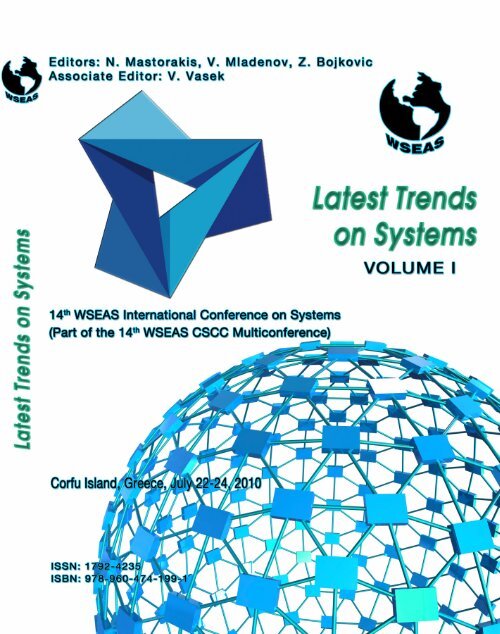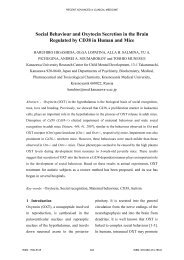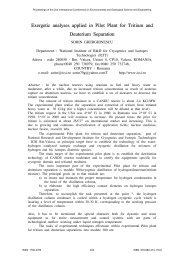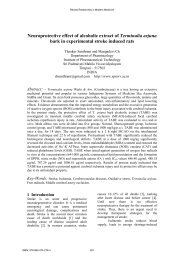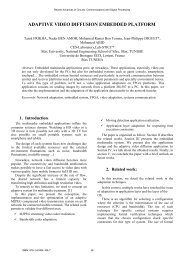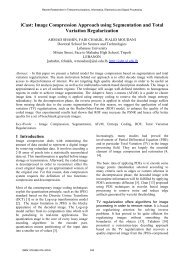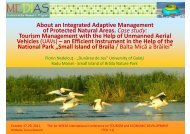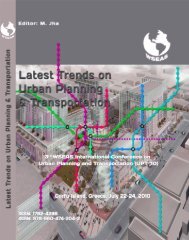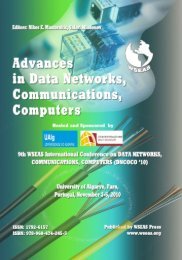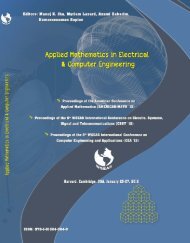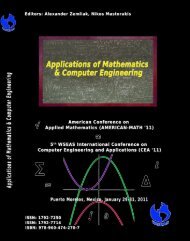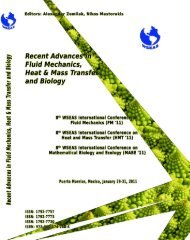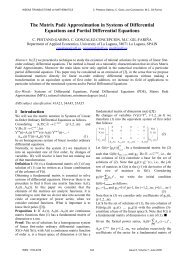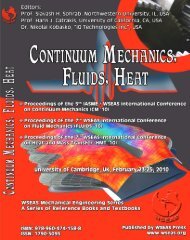Latest trends on systems - Wseas.us
Latest trends on systems - Wseas.us
Latest trends on systems - Wseas.us
- No tags were found...
You also want an ePaper? Increase the reach of your titles
YUMPU automatically turns print PDFs into web optimized ePapers that Google loves.
LATEST TRENDS <strong>on</strong> SYSTEMS(Volume I)14th WSEAS Internati<strong>on</strong>al C<strong>on</strong>ference <strong>on</strong> SYSTEMS(Part of the 14th WSEAS CSCC Multic<strong>on</strong>ference)(Volume I)Corfu Island, GreeceJuly 22-24, 2010Mathematics and Computers in Science EngineeringA Series of Reference Books and TextbooksPublished by WSEAS Presswww.wseas.orgISSN: 1792-4235ISBN: 978-960-474-199-1
LATEST TRENDS <strong>on</strong> SYSTEMS(Volume I)14th WSEAS Internati<strong>on</strong>al C<strong>on</strong>ference <strong>on</strong> SYSTEMS(Part of the 14th WSEAS CSCC Multic<strong>on</strong>ference)(Volume I)Corfu Island, Greece, July 22-24, 2010Mathematics and Computers in Science EngineeringA Series of Reference Books and TextbooksPublished by WSEAS Presswww.wseas.orgCopyright © 2010, by WSEAS PressAll the copyright of the present book bel<strong>on</strong>gs to the World Scientific and Engineering Academy andSociety Press. All rights reserved. No part of this publicati<strong>on</strong> may be reproduced, stored in a retrievalsystem, or transmitted in any form or by any means, electr<strong>on</strong>ic, mechanical, photocopying, recording, orotherwise, without the prior written permissi<strong>on</strong> of the Editor of World Scientific and Engineering Academyand Society Press.All papers of the present volume were peer reviewed by two independent reviewers. Acceptance wasgranted when both reviewers' recommendati<strong>on</strong>s were positive.See also: http://www.worldses.org/review/index.htmlISSN: 1792-4235ISBN: 978-960-474-199-1World Scientific and Engineering Academy and Society
LATEST TRENDS <strong>on</strong> SYSTEMS(Volume I)14th WSEAS Internati<strong>on</strong>al C<strong>on</strong>ference <strong>on</strong> SYSTEMS(Part of the 14th WSEAS CSCC Multic<strong>on</strong>ference)(Volume I)Corfu Island, GreeceJuly 22-24, 2010
Editors:Prof. Nikos E. Mastorakis, BULGARIAProf. Valeri Mladenov, BULGARIAProf. Zoran Bojkovic, SERBIAAssociate Editor:Prof. Vladimir Vasek, CZECH REPUBLICInternati<strong>on</strong>al Program Committee Members:Joseph Sifakis, FRANCELotfi A. Zadeh, USALe<strong>on</strong> O. Chua, USAK. R. Rao, USADimitri Bertsekas, USABiswa N. Datta, USAIrwin Sandberg, USAP. Pardalos, USAA. Manikas, UKT. Kaczorek, POLANDWlodzislaw Duch, POLANDSidney Burr<strong>us</strong>, USALe<strong>on</strong>id G. Kazovsky, USAGeorgios B. Giannakis, USANikolaos G. Bourbakis, USABrian A. Barsky, USARyszard S. Choras, POLANDWasfy B. Mikhael, USAM. Kostic, USAA. Venetsanopoulos, CANADAK. Benra, GERMANYS. Sohrab, USA
PrefaceThis year the 14th WSEAS Internati<strong>on</strong>al C<strong>on</strong>ference <strong>on</strong> SYSTEMS (Part of the 14th WSEASCSCC Multic<strong>on</strong>ference) was held <strong>on</strong> Corfu Island, Greece, July 22-24, 2010. The c<strong>on</strong>ferenceremains faithful to its original idea of providing a platform to disc<strong>us</strong>s <strong>systems</strong> theory, dynamical<strong>systems</strong>, c<strong>on</strong>trol <strong>systems</strong>, robotics, artificial intelligence, genetic algorithms, aerospace <strong>systems</strong>,lightwave engineering, hybrid <strong>systems</strong>, speech and image processing <strong>systems</strong>, envir<strong>on</strong>mentalmodeling, s<strong>on</strong>ar and underwater aco<strong>us</strong>tic <strong>systems</strong>, space <strong>systems</strong>, wavelets, optimizati<strong>on</strong>, finiteelements etc. with participants from all over the world, both from academia and from ind<strong>us</strong>try.Its success is reflected in the papers received, with participants coming from several countries,allowing a real multinati<strong>on</strong>al multicultural exchange of experiences and ideas.The accepted papers of this c<strong>on</strong>ference are published in this Book that will be indexed by ISI.Please, check it: www.worldses.org/indexes as well as in the CD-ROM Proceedings. They willbe also available in the E-Library of the WSEAS. The best papers will be also promoted in manyJournals for further evaluati<strong>on</strong>.A C<strong>on</strong>ference such as this can <strong>on</strong>ly succeed as a team effort, so the Editors want to thank theInternati<strong>on</strong>al Scientific Committee and the Reviewers for their excellent work in reviewing thepapers as well as their invaluable input and advice.The Editors
LATEST TRENDS <strong>on</strong> SYSTEMS (Volume I)Table of C<strong>on</strong>tentsKeynote Lecture 1: Optimizing the Performance of Scientific Java Applicati<strong>on</strong>s 17Kleanthis PsarrisPlenary Lecture 1: Turbulence and Quantum Mechanics from Cosmic to Planck Scales 18Siavash H. SohrabPlenary Lecture 2: Multiple Laplace-Z Transformati<strong>on</strong> and Applicati<strong>on</strong>s in the Study ofC<strong>on</strong>tinuo<strong>us</strong> - Discrete SystemsValeriu Prepelita19Plenary Lecture 3: Supercapacitors Applicati<strong>on</strong> in Energy Hybrid Systems for Automotive 21Carmen Mihaela LungociPlenary Lecture 4: Work Directi<strong>on</strong>s and New Results in Electr<strong>on</strong>ic Travel Aids for Blind andVisually Impaired PeopleVirgil Tip<strong>on</strong>ut22Plenary Lecture 5: Video and Audio Mobile Robot Systems 24Alexander BekiarskiPlenary Lecture 6: N<strong>on</strong>linear Waves 25Petar PopivanovPlenary Lecture 7: The Origin of Life: Informati<strong>on</strong> Theory Perspective 26Krzysztof CyranPlenary Lecture 8: Gradient Theory Across the Scale Spectrum: Examples from Astroscalesand Above to Nanoscales and BelowElias C. AifantisPlenary Lecture 9: N<strong>on</strong>linear Models of Interacti<strong>on</strong>s Am<strong>on</strong>g Two or Three Species : Symbiosis,Prey-Predator, Competiti<strong>on</strong>Daniele Fournier-Prunaret2829Plenary Lecture 10: Accelerate your Favorite Numerical Integrator with Two Lines of Code 30Houman OwhadiPlenary Lecture 11: Logarithmic Number Systems 31Mark ArnoldPlenary Lecture 12: Glocal C<strong>on</strong>trol: Realizati<strong>on</strong> of Global Functi<strong>on</strong>s by Local Acti<strong>on</strong>s 32Shinji HaraPART I 33Default Predicti<strong>on</strong> and Bankruptcy Hazard Analysis into Recurent neuro-genetic hybridnetworks to AdaBoost M1 Regressi<strong>on</strong> and Logistic Regressi<strong>on</strong> Models in FinanceLoukeris Nikolaos, Eleftheriadis Iordanis35ISSN: 1792-4235 9 ISBN: 978-960-474-199-1
LATEST TRENDS <strong>on</strong> SYSTEMS (Volume I)A Study of Evaluating Community Health and Welfare by Fuzzy Analytic Hierarchy Process 42Kuei-Yang Wu, Chia-Sheng LinA Fuzzy Representati<strong>on</strong> of CBR Systems 48Michael Gr. VoskoglouRestructuring Distributi<strong>on</strong> Feeder Through HVDS C<strong>on</strong>cepts 54M. Madh<strong>us</strong>udhana Raju, L. Ramesh, S. P. Chowdhury, S. ChowdhuryA Three Dimensi<strong>on</strong>al Path Planning Algorithm 60Ouarda HachourThe Use of the Hierarchical Structured Dynamic Inversi<strong>on</strong> to the Aircrafts Lateral Movement 66Romul<strong>us</strong> Lungu, Alexander Bekiarski, Mihai Lungu, Madalina CalbureanuAutomatic Vehicle Identifier (AUTOVID) 72Ali S. Saad Azhar, Farhan Aziz, Ahsan Yasin, Ahmad Rauf SubhaniDecisi<strong>on</strong> Support System for Erosi<strong>on</strong> Risk Assessment 76Thomas Panagopoulos, Vera FerreiraDynamic Modeling and Simulati<strong>on</strong> in Virtual Envir<strong>on</strong>ment of an Active S<strong>us</strong>pensi<strong>on</strong> System 81Catalin Alexandru, Petre AlexandruGenerati<strong>on</strong> Expansi<strong>on</strong> Planning in Pool Market: A Hybrid DP/GT Model 87Ali Reza HeidariAllocati<strong>on</strong> of Static VAr Compensators C<strong>on</strong>sidering Voltage Profile, Voltage Stability andPower Loss ImprovementFarzad Kavehnia93PDF Estimati<strong>on</strong> via Characteristic Functi<strong>on</strong> and an Orth<strong>on</strong>ormal Basis Set 100Roy M. HowardA New Solar Radiati<strong>on</strong> Models for Iran 106Shahram Javadi, Sam MoiniA Fuzzy Differential Approach to Str<strong>on</strong>g Allee Effect Based <strong>on</strong> the Fuzzy Extensi<strong>on</strong> Principle 111Xavier Bertran, Narcis Clara, Joan Carles FerrerDepointing Influence of Antenna <strong>on</strong> the Link Budget at the Recepti<strong>on</strong> 117Mohammed Ali Mebrek, Mohammed BekhtiMoti<strong>on</strong> C<strong>on</strong>trol of X4-Flyer for Enhanced Situati<strong>on</strong>al Awareness 123Igor Astrov, Andr<strong>us</strong> PedaiModeling of Raw Materials Blending in Raw Meal Grinding Systems 129Dimitris TsamatsoulisCase of Enr<strong>on</strong>: Failure of Measurement System? 135Jiri Strouhal, Carmen B<strong>on</strong>aci, Dumitru Matis, Razvan M<strong>us</strong>tataOn the Perturbati<strong>on</strong>s of the Lyapunov Exp<strong>on</strong>ents of Discrete Linear System 141Adam Czornik, Aleksander NawratISSN: 1792-4235 10 ISBN: 978-960-474-199-1
LATEST TRENDS <strong>on</strong> SYSTEMS (Volume I)Nuclear F<strong>us</strong>i<strong>on</strong> C<strong>on</strong>trol-Oriented Plasma Current Linear Models 145Aitor J. Garrido, Izaskun Garrido, M. Goretti Sevillano, Mikel Alberdi, Modesto Amundarain, OscarBaramb<strong>on</strong>es, Manuel De la SenN<strong>on</strong>linearly Coupled Oscillators and State Space Energy Approach 151Milan Stork, Josef Hr<strong>us</strong>ak, Daniel MayerN<strong>on</strong>invasive Cardiac Output Estimati<strong>on</strong> Based <strong>on</strong> Oxygen C<strong>on</strong>sumpti<strong>on</strong> During Stress Test 159M. Stork, J. Novak, V. ZemanAn Analogical Distance Relay for the 110kV Electric Lines 165Gabriel Nicolae Popa, Sorin Deac<strong>on</strong>u, Corina Maria Dinis, Angela IagarDual-cuff System for Improved Determinati<strong>on</strong> of Blood Pressures and Hemodynamics 171J. Jilek, M. StorkNew Seismocardiographic Measuring System with Separate QRS Detecti<strong>on</strong> 176M. Stork, Z. TrefnyTree Axis Attitude C<strong>on</strong>trol Using Sliding Mode for LEO Microsatellite 181A. Bellar, B. Seba, A. M. Si Mohammed, M. N. SweetingAn Adaptive Multi Sensor Data F<strong>us</strong>i<strong>on</strong> with Hybrid N<strong>on</strong>linear ARX and Wiener-HammersteinModels for Skeletal M<strong>us</strong>cle Force Estimati<strong>on</strong>Parmod Kumar, Chandrasekhar Potluri, Anish Sebastian, Steve Chiu, Alex Urfer, D. SubbaramNaidu, Marco P. Schoen186Elaborated Moti<strong>on</strong> Detector Based <strong>on</strong> Hassenstein-Reichardt Correlator Model 192Mihai-Emanuel Basch, David-George Cristea, Virgil Tip<strong>on</strong>ut, Tit<strong>us</strong> SlaviciComputer Aided Decisi<strong>on</strong> in Cataract Surgery 196Kla<strong>us</strong> Peter Scherer, Helmut Guth, Thomas GrafPrototype Testing of a New Laser Range Finder for Air Traffic Management 201Mario Salerno, Giovanni Costantini, Massimo Carota, Daniele Casali, Massimiliano Todisco,Stefano BocchettiM<strong>us</strong>ical Onset Detecti<strong>on</strong> by Means of N<strong>on</strong>-Negative Matrix Factorizati<strong>on</strong> 206Giovanni Costantini, Massimiliano Todisco, Giovanni SaggioFuncti<strong>on</strong>ing Analysis of a High Frequency Electro Thermal Installati<strong>on</strong> with ElectromagneticInducti<strong>on</strong> Using PSCAD-EMTDC ToolRaluca Rob, Ioan Sora, Cai<strong>us</strong> Panoiu, Manuela PanoiuMeasurements of the Electrical Parameters of an Electro Thermal Installati<strong>on</strong> withElectromagnetic Inducti<strong>on</strong>Cai<strong>us</strong> Panoiu, Raluca Rob, Manuela Panoiu, Gabriel Popa210216Modern Equipment for Recording and Analyzing the Events in Electric Stati<strong>on</strong>s 222Angela Iagar, Gabriel Nicolae Popa, Corina Maria DinisTowards Multi-Robot Independent Visual SLAM 228M<strong>on</strong>ica Ballesta, Arturo Gil, Oscar Reinoso, Luis Paya, Luis M. JimenezISSN: 1792-4235 11 ISBN: 978-960-474-199-1
LATEST TRENDS <strong>on</strong> SYSTEMS (Volume I)Symbolic Analysis of Mechatr<strong>on</strong>ic Systems 234Dalibor Biolek, Jaroslav Kalo<strong>us</strong>, Zdenek KolkaMultimedia Surveillance Stati<strong>on</strong> for Audio-Visual Objects Tracking with Mobile Robot 240Alexander Bekiarski, Emil Altimirski, Snejana PleshkovaMicroc<strong>on</strong>troller Based Self-Tuning Digital PID C<strong>on</strong>troller 248Petr Dostalek, Libor Pekar, Vladimir Vasek, Jan DolinayForecast of Heat Demand According the Box-Jenkins Methodology for Specific Locality 252Br<strong>on</strong>islav ChramcovSoftware Implementati<strong>on</strong> of the C<strong>on</strong>trol System for Dechromati<strong>on</strong> of Tannery Waste Water 257Jan Dolinay, Petr Dostalek, Vladimir Vasek, Karel Kolomaznik, Dagmar JanacovaApplicati<strong>on</strong> of Kr<strong>on</strong>ecker Summati<strong>on</strong> Method in Computati<strong>on</strong> of Rob<strong>us</strong>tly Stabilizing PIC<strong>on</strong>trollers for Interval PlantsRadek Mat<strong>us</strong>u, Roman Prokop, Katarina Matejickova, M<strong>on</strong>ika Bakosova261Sunny Day as Sharping Factor of Heat C<strong>on</strong>sumpti<strong>on</strong> Survey 268Viliam Dolinay, Jiri Palka, Lubomir VasekN<strong>on</strong>-delay Parameter Depending Stability of a Time-Delay System 271Libor Pekar, Roman ProkopArgument Principle Based Stability C<strong>on</strong>diti<strong>on</strong>s of a Retarded Quasipolynomial with TwoDelaysLibor Pekar, Roman Prokop276Improved p-Delta Learning Algorithm 282R. Mirsu, V. Tip<strong>on</strong>ut, L. Petromanjanc, Z. HaraszyAutomatic M<strong>us</strong>ic Transcripti<strong>on</strong> Based <strong>on</strong> N<strong>on</strong>-Negative Matrix Factorizati<strong>on</strong> 288Giovanni Costantini, Massimiliano Todisco, Giovanni SaggioModified Floyd-Warshall Algorithm for Risk Arbitrage 292Ch. Mouratidis, G. Majchrowska, D. Zissopoulos, N. AsimopoulosAbout Root-Cl<strong>us</strong>tering in Sophisticated Regi<strong>on</strong>s 297Vitaly G. MelnikovChebyshev Ec<strong>on</strong>omizati<strong>on</strong> in Transformati<strong>on</strong>s of N<strong>on</strong>linear Systems with PolynomialStructureVitaly G. Melnikov301Specialized Micro Grid (IDAPS) for Intelligently Managing C<strong>us</strong>tomer-Owned DER’s 304Jarupula SomlalPower Upgrading of Transmissi<strong>on</strong> Line by Combining AC-DC Transmissi<strong>on</strong> 311Jarupula SomlalAnalysis and Modeling of High Performance and Low Power UTB SGOI Devices Scalable tosub 30 nmKiran Bailey, K. S. Gurumurthy319ISSN: 1792-4235 12 ISBN: 978-960-474-199-1
LATEST TRENDS <strong>on</strong> SYSTEMS (Volume I)A Fully Automated Water Management System for Large Rice Paddies 325Teruji SekozawaStudy of the D.C. Motors’ Behavior from the Comp<strong>on</strong>ency of Electric Tracti<strong>on</strong> Systems inShort-Circuit RegimeIoan Baciu, Corina Daniela Cuntan, Sorin Deac<strong>on</strong>u, Anca Iordan331Neuro-Fuzzy C<strong>on</strong>trol of Chemical Reactor with Disturbances 336Lenka Blahova, Jan DvoranRob<strong>us</strong>t Static Output Feedback Stabilizati<strong>on</strong> of an Exothermic Chemical Reactor with InputC<strong>on</strong>straintsM<strong>on</strong>ika Bakosova, Anna Vasickaninova, Maria KarsaiovaWork Directi<strong>on</strong>s and New Results in Electr<strong>on</strong>ic Travel Aids for Blind and Visually ImpairedPeopleVirgil Tip<strong>on</strong>ut, Daniel Ianchis, Mihai Bash, Zoltan Haraszy341347PART II 353Applicati<strong>on</strong> of Novel Adaptive C<strong>on</strong>trol of STATCOM in Wind Power Generati<strong>on</strong> 355Nikolay Djagarov, Zhivko Grozdev, Milen B<strong>on</strong>ev, Stefan FilchevDefects and C<strong>on</strong>ductivity of DNAsA. Yu. Kasumov, A. Chepelianskii, S. Guer<strong>on</strong>, H. Bouchiat, S. Nakamae, M. Cazayo<strong>us</strong>, T. Kawasaki,Y. Okahata, D. Klinov360From "Knotted Particles" to Some Cosmological Problems 366Diana T. VashakmadzeDesign and Fabricati<strong>on</strong> of an Intelligent Irrigati<strong>on</strong> C<strong>on</strong>trol System 370A. Algeeb, A. Albagul, A. Asseni, O. Khalifa, O. S. JomahShape of a Drum, a C<strong>on</strong>structive Approach 376P. N. Shivakumar, Yan WuDesign of Rob<strong>us</strong>t PI C<strong>on</strong>trollers for C<strong>on</strong>trol of an Exothermic Chemical Reactor 387Jana Zavacka, M<strong>on</strong>ika Bakosova, Katarina VanekovaUncertainty Bounds for Gramian-Based Interacti<strong>on</strong> Measures 393Bjorn Halvarss<strong>on</strong>, Miguel Castano, Wolfgang BirkMulti-Subject Head Related Transfer Functi<strong>on</strong> Generati<strong>on</strong> <strong>us</strong>ing Artificial Neural Networks 399Zoltan Haraszy, Sebastian Micut, Virgil Tip<strong>on</strong>ut, Tit<strong>us</strong> SlaviciAn Adaptive C<strong>on</strong>trol Strategy for a Five-Fingered Prosthetic Hand 405Cheng-Hung Chen, D. Subbaram Naidu, Marco P. SchoenImproved Head Related Transfer Functi<strong>on</strong> Generati<strong>on</strong> and Testing for Aco<strong>us</strong>tic VirtualReality DevelopmentZoltan Haraszy, David-George Cristea, Virgil Tip<strong>on</strong>ut, Tit<strong>us</strong> Slavici411On Designing an Experimental Navigati<strong>on</strong> System 417Tomas NestorovicISSN: 1792-4235 13 ISBN: 978-960-474-199-1
LATEST TRENDS <strong>on</strong> SYSTEMS (Volume I)Numerical Operability Analysis of Multidimensi<strong>on</strong>al Systems with Interval Parameters UsingInterval Degenerati<strong>on</strong> FactorsNatalia Dudarenko, Anatoly Ushakov422Utilizati<strong>on</strong> of Power Line for Remote C<strong>on</strong>trol of Electrical Appliances 427Milan Adamek, Pavel Martinec, Petr NeumannSwitching Power Supply Unit for an Aut<strong>on</strong>omo<strong>us</strong> M<strong>on</strong>itoring System 431Martin Pospisilik, Milan AdamekC<strong>on</strong>trol of Thermal Accummulative Panels as Active Elements of Heat Accummulati<strong>on</strong> inLaboratory of Intelligent BuildingMartin Zalesak435Simulati<strong>on</strong> Model of Heat Distributi<strong>on</strong> and C<strong>on</strong>sumpti<strong>on</strong> in Municipal Heating Network 439L. Vasek, V. DolinaySignal Interpolati<strong>on</strong> <strong>us</strong>ing Numerically Rob<strong>us</strong>t Differential Operators 443Aleksandar IgnjatovicResource Sharing, Self-Growing Populati<strong>on</strong>s of Discrete-Time Systems 452Tiberiu VasilacheA Study <strong>on</strong> Hybridizati<strong>on</strong> of Particle Swarm and Tabu Search Algorithms for Unc<strong>on</strong>strainedOptimizati<strong>on</strong> and Estimati<strong>on</strong> ProblemsAnish Sebastian, Parmod Kumar, Marco P. SchoenSystem based <strong>on</strong> Fuzzy Logic for Maintain Optimum Envir<strong>on</strong>mental C<strong>on</strong>diti<strong>on</strong>s in a Fir TreeGreenho<strong>us</strong>eManuela Panoiu, Cai<strong>us</strong> Panoiu, Raluca Rob, Loredana Ghiorghi<strong>on</strong>i458464Two Step, PID and Model Predictive C<strong>on</strong>trol Applied <strong>on</strong> Fed Batch Process 470Lubomir Macku, David SamekImprovement of the EAF's Energetic Parameters <strong>us</strong>ing Capacitive-Inductive Filters 474Sorin Ioan Deac<strong>on</strong>u, Marcel Topor, Gabriel Nicolae Popa, Tihomir LatinovicTurbulence and Quantum Mechanics from Cosmic to Planck Scales 480Siavash H. SohrabPhotovoltaic System in System LABI 498Hr<strong>us</strong>ka FrantisekDevelopment against Poverty: A Dynamic Simulati<strong>on</strong> Model 501Gabriel Murrieta Hernandez, Heriberto E. Cuanalo De La CerdaModelling Integrated Waste Management System of the Czech Republic 510Jiri Hrebicek, Jana SoukopovaAdaptive, Model-Following C<strong>on</strong>trol of Chaotic Systems 516Jacek KabzinskiSurvivor Search <strong>us</strong>ing a Quasi-2D-Parallax Algorithm with Massive Microrobot Swarms 522Jung Ho Cho, Mark G. ArnoldISSN: 1792-4235 14 ISBN: 978-960-474-199-1
LATEST TRENDS <strong>on</strong> SYSTEMS (Volume I)Motor Voltage Asymmetry Influence to the Efficient Energy Usage 526Miloje Kostic, Aleksandar NikolicApplied C<strong>on</strong>tinuo<strong>us</strong> – Time Self – Tuning C<strong>on</strong>trol 532Marek Kubalcik, Vladimir BobalThe Intrinsic System Model of the Simple Genetic Algorithm with α-Selecti<strong>on</strong>, UniformCrossover and Bitwise Mutati<strong>on</strong>Andre Neubauer538A Stochastic Petri Net Approach for the Manufacturing System Design 544Daniela Coman, Adela I<strong>on</strong>escu, Mari<strong>us</strong> Gigi ComanModeling of N<strong>on</strong>-Stati<strong>on</strong>ary Heat Field in a Plane Plate for Asymmetric Problem 550Dagmar Janacova, Hana Charvatova, Karel Kolomaznik, Vladimir Vasek, Pavel MokrejsGeneral q-Exp<strong>on</strong>ential Model for Tree Height, Volume and Stem Profile 555Edmundas Petra<strong>us</strong>kas, Petras RupsysInvestigati<strong>on</strong> of Tree Diameter and Volume Increments <strong>us</strong>ing Stochastic Differential Equati<strong>on</strong>s 561Edmundas Petra<strong>us</strong>kas, Petras RupsysElectromagnetic Field of the Large Power Cables and Interacti<strong>on</strong> with the Human Body 567Daniela CarsteaDirect Search as Unsupervised Training Algorithm for Neural Networks 575Catalin-Daniel Caleanu, Xia Mao, Vigil Tip<strong>on</strong>ut, Yuli XueN<strong>on</strong>invasive Medical Examinati<strong>on</strong> and Optimal Physical Activity Prescripti<strong>on</strong> Based <strong>on</strong> StressTestM. Stork, J. Novak, V. Zeman580Autocorrelati<strong>on</strong> Functi<strong>on</strong> for a Noisy Fracti<strong>on</strong>al Oscillator 585Ako Sauga, Romi Mankin, Ain AinsaarA New Face Database and Evaluati<strong>on</strong> of Face Recogniti<strong>on</strong> Techniques 590D. Alexiadis, V. Syrris, A. Papastergiou, A. Hatzigaidas, L. MariutaAn Improved Low Power Wireless Sensor Network based <strong>on</strong> ZigBee for AgriculturalApplicati<strong>on</strong>sK. Tsiakmakis, N. Mallios, N. Charalampidis, M. Spasos596Signal Rec<strong>on</strong>structi<strong>on</strong> in ANS-DM Decoder 602Ryszard Golanski, Jacek Kolodziej, Stanislaw KutaOz<strong>on</strong>e Day Predicti<strong>on</strong> with Radial Basis Functi<strong>on</strong> Networks 608Hy<strong>on</strong>tai SugProperty of Artificial Neural Networks of Classificati<strong>on</strong> with Respect to Training Set Size 612Hy<strong>on</strong>tai SugOptimizati<strong>on</strong> of Re-Handling and Load/Unload Operati<strong>on</strong>s in Small C<strong>on</strong>tainer TerminalOperated by ReachstackersAdam Gal<strong>us</strong>zka, Krzysztof Daniec616ISSN: 1792-4235 15 ISBN: 978-960-474-199-1
LATEST TRENDS <strong>on</strong> SYSTEMS (Volume I)Numerical Computati<strong>on</strong> of a Problem of Coupled Fields in a Coreless Inducti<strong>on</strong> Furnace 622Gheorghe Dan SoreaA Modality to Improve the Dynamic Behavior for Power Supply or for Batteries 626Ioan D. OlteanNumerical Simulati<strong>on</strong> of Thermoelectric System 630Elena-Otilia Virjoghe, Diana Enescu, Marcel I<strong>on</strong>el, Mihail-Florin StanAlgorithm for Exact Determinati<strong>on</strong> of Three-Phase Inducti<strong>on</strong> Machine Parameters 636Marcel I<strong>on</strong>el, Mihail-Florin Stan, Elena-Otilia Virjoghe, Octavian-Marcel I<strong>on</strong>elThe Simulati<strong>on</strong> of A.C. Adj<strong>us</strong>table Electric Drive Systems 644Mihail-Florin Stan, Marcel I<strong>on</strong>el, Octavian-Marcel I<strong>on</strong>elNumerical Modeling of Heat Transfer Phenomena in Bodies with Mobile Boundaries 651Diana Enescu, Elena Otilia VirjogheUsage of PSO Algorithm for Parameters Identificati<strong>on</strong> of District Heating Network Simulati<strong>on</strong>ModelErik Kral, Vasek Lubomir, Viliam Dolinay, Pavel Varacha657Thermal Lifetime of Transformer Electroinsulating Oils 660Elena Helerea, Adrian MunteanuReliability Evaluati<strong>on</strong> of Power System Operati<strong>on</strong> under Discrete Multi-Factor Effects 666Mahmoud S. AwadLocally Optimal Fuzzy C<strong>on</strong>trol of a Heat Exchanger 670Anna Vasickaninova, M<strong>on</strong>ika BakosovaN<strong>on</strong>-Enzymatic Template-Directed RNA Recombinati<strong>on</strong> Processes in M<strong>on</strong>te Carlo Simulati<strong>on</strong>Model of the RNA WorldDari<strong>us</strong>z Myszor, Krzysztof A. Cyran676Geometric Approach to Inverse Kinematics for Arm Manipulator 682Krzysztof Tokarz, Slawosz KieltykaAuthors Index 688ISSN: 1792-4235 16 ISBN: 978-960-474-199-1
LATEST TRENDS <strong>on</strong> SYSTEMS (Volume I)Keynote Lecture 1Optimizing the Performance of Scientific Java Applicati<strong>on</strong>sProfessor Kleanthis PsarrisDepartment of Computer ScienceThe University of Texas at San Ant<strong>on</strong>ioSan Ant<strong>on</strong>io, TX 78249USAE-mail: psarris@cs.utsa.eduAbstract: As part of its type-safety regime, the Java semantics require precise excepti<strong>on</strong> at runtime when programsattempt out-of-bound array accesses. In general, this requires a dynamic bounds check each time an array element isaccessed, which limits the performance of array intensive scientific applicati<strong>on</strong>s implemented in Java. However, if itcan be proven that the array index is within the bounds of the array, the check can be eliminated. We present a newalgorithm based <strong>on</strong> extended Static Single Assignment (eSSA) form that builds a c<strong>on</strong>straint system representingc<strong>on</strong>trol flow qualified, linear c<strong>on</strong>straints am<strong>on</strong>g program variables derived from program statements. Our system thenderives relati<strong>on</strong>ships am<strong>on</strong>g variables, and provides a verifiable proof of its c<strong>on</strong>cl<strong>us</strong>i<strong>on</strong>s. This proof can be verified bya runtime system to minimize the analysis’ performance impact. Our system simultaneo<strong>us</strong>ly c<strong>on</strong>siders both c<strong>on</strong>trolflow and data flow when analyzing the c<strong>on</strong>straint system, handles general linear inequalities instead of simpledifference c<strong>on</strong>straints, and provides verifiable proofs for its claims. We present experimental results dem<strong>on</strong>stratingthat this method eliminates more bounds checks than prior approaches with minimal overhead during JIT compilati<strong>on</strong>.Furthermore our algorithm increased the speed at which the Java benchmarks executed by up to 16%.Brief Biography of the Speaker:Kleanthis Psarris is Professor and Chair of the Department of Computer Science at the University of Texas at SanAnt<strong>on</strong>io. He received his B.S. degree in Mathematics from the Nati<strong>on</strong>al University of Athens, Greece in 1984. Hereceived his M.S. degree in Computer Science in 1987, his M.Eng. degree in Electrical Engineering in 1989 and hisPh.D. degree in Computer Science in 1991, all from Stevens Institute of Technology in Hoboken, New Jersey. Hisresearch interests are in the areas of Parallel and Distributed Systems, Programming Languages and Compilers, andHigh Performance Computing. He has designed and implemented state of the art program analysis and compileroptimizati<strong>on</strong> techniques and he developed compiler tools to increase program parallelizati<strong>on</strong> and improve executi<strong>on</strong>performance <strong>on</strong> advanced computer architectures. He has published extensively in top journals and c<strong>on</strong>ferences inthe field and his research has been funded by the Nati<strong>on</strong>al Science Foundati<strong>on</strong> and Department of Defenseagencies. He is an Editor of the Parallel Computing journal. He has served <strong>on</strong> the Program Committees of severalinternati<strong>on</strong>al c<strong>on</strong>ferences including the ACM Internati<strong>on</strong>al C<strong>on</strong>ference <strong>on</strong> Supercomputing (ICS) in 1995, 2000, 2006and 2008, the IEEE Internati<strong>on</strong>al C<strong>on</strong>ference <strong>on</strong> High Performance Computing and Communicati<strong>on</strong>s (HPCC) in2008, 2009, and 2010, and the ACM Symposium <strong>on</strong> Applied Computing (SAC) in 2003, 2004, 2005 and 2006.ISSN: 1792-4235 17 ISBN: 978-960-474-199-1
LATEST TRENDS <strong>on</strong> SYSTEMS (Volume I)Plenary Lecture 1Turbulence and Quantum Mechanics from Cosmic to Planck ScalesProfessor Siavash H. SohrabRobert McCormick School of Engineering and Applied ScienceDepartment of Mechanical EngineeringNorthwestern University, Evanst<strong>on</strong>, Illinois 60208USAE-mail: s-sohrab@northwestern.eduAbstract: A scale invariant model of statistical mechanics was recently applied to describe a modified statisticaltheory of turbulence and its quantum mechanical foundati<strong>on</strong>. In the present study the implicati<strong>on</strong>s of the results to aunified statistical theory of fields with applicati<strong>on</strong>s to diverse physical <strong>systems</strong> in the fields of galacto-dynamics(cosmology), hydrodynamics, molecular-dynamics, electrodynamics, and quantum optics (dry-hydrodynamics) will bedisc<strong>us</strong>sed. The comparis<strong>on</strong>s between the predicti<strong>on</strong>s of the model and some of the available experimentalobservati<strong>on</strong>s over the entire range of spatial scales from cosmic to Planck will be examined. The c<strong>on</strong>necti<strong>on</strong> betweenthe cosmological c<strong>on</strong>stant and the vacuum energy and the c<strong>on</strong>cept of negative pressure will be disc<strong>us</strong>sed. In the fieldof optics, the implicati<strong>on</strong>s of the important and central questi<strong>on</strong>: "M<strong>us</strong>t the phot<strong>on</strong> mass be zero?" asked by Bass andSchrodinger [Proc. Royal Soc. A 232, pp: 1-6 (1955)] will be further examined. Also, the implicati<strong>on</strong>s of the invariantmodel of statistical mechanics to the classical theory of electrodynamics of Maxwell and Lorentz will be exploredwhen the compressible nature of physical space, in accordance with Planck's compressible ether, is taken intoaccount. In particular, the existence of l<strong>on</strong>gitudinal electromagnetic waves, L-waves, and their impact <strong>on</strong> thegravitati<strong>on</strong>al mass of phot<strong>on</strong> will be disc<strong>us</strong>sed. Finally, the physical and quantum nature of time will be described anda scale-invariant definiti<strong>on</strong> of time will be presented and its physical significance to vario<strong>us</strong> <strong>systems</strong> as well as itsrelativistic behavior will be addressed.Brief Biography of the Speaker:Siavash H. Sohrab received his PhD in Engineering Physics in 1981 from University of California, San Diego, his MSdegree in Mechanical Engineering from San Jose State University in 1975, and his BS degree in MechanicalEngineering from the University of California, Davis in 1973. He then joined Northwestern University in 1982 aspostdoctoral research assistant and became Visiting Assistant Professor in 1983, Assistant Professor of MechanicalEngineering in 1984, and since 1990 he is Associate Professor of Mechanical Engineering at the NorthwesternUniversity. From 1975-1978 he worked as a scientist doing research <strong>on</strong> fire protecti<strong>on</strong> and turbulent comb<strong>us</strong>ti<strong>on</strong> atNASA Ames research center in California. His research interests have been <strong>on</strong> comb<strong>us</strong>ti<strong>on</strong>, fluid dynamics,thermodynamics, and statistical and quantum mechanics.ISSN: 1792-4235 18 ISBN: 978-960-474-199-1
LATEST TRENDS <strong>on</strong> SYSTEMS (Volume I)Plenary Lecture 2Multiple Laplace-Z Transformati<strong>on</strong> and Applicati<strong>on</strong>s in the Study of C<strong>on</strong>tinuo<strong>us</strong> - DiscreteSystemsProfessor Valeriu PrepelitaUniversity Politehnica of BucharestDepartment of Mathematics-Informatics ISplaiul Independentei 313, 060042 BucharestROMANIAE-mail: vprepelita@mathem.pub.roAbstract: The Operati<strong>on</strong>al Calcul<strong>us</strong> as a distinct discipline has a history which has exceeded a century. But its rootscan be found in the works of Leibniz, Bernoulli, Lagrange, Laplace, Euler, Fourier, Cauchy and others. Its importanceis determined by its utility in solving complex problems in many domains such as Calcul<strong>us</strong>, Number Theory, SpecialFuncti<strong>on</strong>s, Ordinary Differential Equati<strong>on</strong>s, Mathematical Physics, Heat Transfer, Electr<strong>on</strong>ics, Automatics, etc.In Systems and C<strong>on</strong>trol Theory the frequency domain methods, based <strong>on</strong> Laplace transformati<strong>on</strong> in the c<strong>on</strong>tinuo<strong>us</strong>timecase or <strong>on</strong> Z transformati<strong>on</strong> in the discrete-time case, play a very important role in the study of the "classical" 1D<strong>systems</strong>.In the last two decades the study of two-dimensi<strong>on</strong>al (2D) <strong>systems</strong> (and more generally, of n-dimensi<strong>on</strong>al <strong>systems</strong>)developed as a distinct branch of Systems Theory, due to its applicati<strong>on</strong>s in vario<strong>us</strong> domains as image processing,seismology and geophysics, c<strong>on</strong>trol of multipass processes etc.The two-dimensi<strong>on</strong>al (2D) <strong>systems</strong> were obtained from classical 1D linear dynamical <strong>systems</strong> by generalizing from asingle time variable to two (space) variables. Different state space models for 2D <strong>systems</strong> have been proposed byRoesser, Fornasini and Marchesini, Attasi, Eising and others.A subclass of 2D <strong>systems</strong> is represented by <strong>systems</strong> which are c<strong>on</strong>tinuo<strong>us</strong> with respect to <strong>on</strong>e variable and discretewith respect to another <strong>on</strong>e. The c<strong>on</strong>tinuo<strong>us</strong>-discrete models have applicati<strong>on</strong>s in many problems like the iterativelearning c<strong>on</strong>trol synthesis, repetitive processes or in engineering problems such as metal rolling.In order to extend the frequency domain methods to these multiple hybrid <strong>systems</strong> <strong>on</strong>e needs a generalizati<strong>on</strong> of theLaplace and Z transformati<strong>on</strong>.The aim of this paper is to give a complete analysis of a suitable hybrid Laplace-Z type transformati<strong>on</strong> and toemphasize its applicati<strong>on</strong>s in the study of multidimensi<strong>on</strong>al c<strong>on</strong>tinuo<strong>us</strong>-discrete <strong>systems</strong> or for solving multiple hybridequati<strong>on</strong>s.In secti<strong>on</strong> 2 the c<strong>on</strong>tinuo<strong>us</strong>-discrete original functi<strong>on</strong>s are defined and it is shown that their set is a complexcommutative linear algebra with unity. A multiple hybrid Laplace-Z transformati<strong>on</strong> is defined as a linear operatordefined <strong>on</strong> this algebra and taking values in the set of multivariable functi<strong>on</strong>s which are analytic over a suitabledomain.In secti<strong>on</strong> 3 the main properties of the multiple hybrid Laplace-Z transformati<strong>on</strong> are stated and proved, includinglinearity, homothety, two time-delay theorems, translati<strong>on</strong>, differentiati<strong>on</strong> and difference of the original, differentiati<strong>on</strong>of the image, integrati<strong>on</strong> and sum of the original, integrati<strong>on</strong> of the image, c<strong>on</strong>voluti<strong>on</strong>, product of originals, initial andfinal values.Secti<strong>on</strong> 4 is devoted to the inversi<strong>on</strong> problem. Some formulas and methods for determining the original are given.This hybrid transformati<strong>on</strong> is employed in Secti<strong>on</strong> 5 to obtain transfer matrices for different classes of 2D (and moregenerally (q,r)-D) c<strong>on</strong>tinuo<strong>us</strong>-discrete linear c<strong>on</strong>trol <strong>systems</strong> of Roesser-type, Fornasini-Marchesini-type and Attasitype models, including descriptor and delayed <strong>systems</strong>.The realizati<strong>on</strong> problem is studied in Secti<strong>on</strong> 6. Two can<strong>on</strong>ical c<strong>on</strong>trollable and observable realizati<strong>on</strong>s are provided.An algorithm is proposed which determines a minimal realizati<strong>on</strong> for separable (q,r)-D multi-input-multi-output (MIMO)<strong>systems</strong>. This method generalizes to (q,r)-D <strong>systems</strong> the celebrated Ho-Kalman algorithm. The proposed algorithmcan also be <strong>us</strong>ed for MIMO separable nD discrete-time linear <strong>systems</strong> or for MIMO nD <strong>systems</strong> described by a classof hyperbolic partial differential equati<strong>on</strong>s.ISSN: 1792-4235 19 ISBN: 978-960-474-199-1
LATEST TRENDS <strong>on</strong> SYSTEMS (Volume I)Brief Biography of the Speaker:Valeriu Prepelita graduated from the Faculty of Mathematics-Mechanics of the University of Bucharest in 1964. Heobtained Ph.D. in Mathematics at the University of Bucharest in 1974. He is currently Professor at the Faculty ofApplied Sciences, the University Politehnica of Bucharest, Head of the Department Mathematics-Informatics. Hisresearch and teaching activities have covered a large area of domains such as Systems Theory and C<strong>on</strong>trol,Multidimensi<strong>on</strong>al Systems, Functi<strong>on</strong>s of a Complex Variables, Linear and Multilinear Algebra, Special Functi<strong>on</strong>s,Ordinary Differential Equati<strong>on</strong>s, Partial Differential Equati<strong>on</strong>s, Operati<strong>on</strong>al Calcul<strong>us</strong>, Probability Theory andStochastic Processes, Operati<strong>on</strong>al Research, Mathematical Programming, Mathematics of Finance.Professor Valeriu Prepelita is author of more than 100 published papers in refereed journals or c<strong>on</strong>ferenceproceedings and author or co-author of 12 books. He has participated in many nati<strong>on</strong>al and internati<strong>on</strong>al grants. He ismember of the Editorial Board of some journals, member in the Organizing Committee and the Scientific Committeeof several internati<strong>on</strong>al c<strong>on</strong>ferences, keynote lecturer or chairman of some secti<strong>on</strong>s of these c<strong>on</strong>ferences. He is areviewer for five internati<strong>on</strong>al journals. He received the Award for Distinguished Didactic and Scientific Activity of theMinistry of Educati<strong>on</strong> and Instructi<strong>on</strong> of Romania.ISSN: 1792-4235 20 ISBN: 978-960-474-199-1
LATEST TRENDS <strong>on</strong> SYSTEMS (Volume I)Plenary Lecture 3Supercapacitors Applicati<strong>on</strong> in Energy Hybrid Systems for AutomotiveDr. Carmen Mihaela LungociElectrical Engineering and Computers Science FacultyElectrical Engineering DepartmentTransilvania University of Brasov, RomaniaE-mail: lungoci@unitbv.roAbstract: Energy hybrid <strong>systems</strong> are key elements in automotive, that meet the energy demands of tracti<strong>on</strong> engine,provide a c<strong>on</strong>venient life and present a minimum weight and volume. Supercapacitors are devices able to meetspecified demands, especially when they work together with the other energy sources, such as batteries.Present research aims to develop an energy hybrid system for transport, <strong>us</strong>ing batteries and supercapacitors, inorder to optimize it’s energy management. To achieve this goal, several steps are taken in account.Based <strong>on</strong> a synthetic analysis <strong>on</strong> superacapacitors, models are developed and determinati<strong>on</strong>s are carried out, tocharacterize and determine the type of supercapacitors pack to be <strong>us</strong>ed in the proposed applicati<strong>on</strong>s.Two architectures of hybrid energy <strong>systems</strong> are presented and their operating regimes are detailed. Mathematicalmodeling is carried out, models for the comp<strong>on</strong>ents and for the two hybrid <strong>systems</strong> being obtained.The final part is intended to simulati<strong>on</strong> and experimental tests, d<strong>on</strong>e for both tracti<strong>on</strong> applicati<strong>on</strong>s proposed. Throughthe data results, supercapacitors c<strong>on</strong>tributi<strong>on</strong> is underlined by a comparative analysis of main parameters provided bysimulati<strong>on</strong>s and experiments too. The energy management is also presented, in a traditi<strong>on</strong>al system with batteriesand in a hybrid system that c<strong>on</strong>tains supercapacitors and batteries.Brief Biography of the Speaker:Carmen Mihaela Lungoci received the B.Sc. in 1990 <strong>on</strong> the Automati<strong>on</strong> for Ind<strong>us</strong>trial C<strong>on</strong>trol from PolitehnicaUniversity, Bucharest and the M.S.E.E. degree in 2004 from Transilvania University of Brasov, Romania andTechnology University of Belfort, France. In 2009 she received the Ph.D. degrees in Electrical Engineering fromTransilvania University of Brasov, Romania. She is lecturer at this university, <strong>on</strong> the Electrical EngineeringDepartment of the Electrical Engineering and Computers Science Faculty. Her current research interests includessupercapacitors, energy management in automotive <strong>systems</strong> and c<strong>on</strong>trol strategies in hybrid <strong>systems</strong>.ISSN: 1792-4235 21 ISBN: 978-960-474-199-1
LATEST TRENDS <strong>on</strong> SYSTEMS (Volume I)Plenary Lecture 4Work Directi<strong>on</strong>s and New Results in Electr<strong>on</strong>ic Travel Aids for Blind and VisuallyImpaired PeopleProfessor Virgil Tip<strong>on</strong>utElectr<strong>on</strong>ic and Telecommunicati<strong>on</strong> FacultyPOLITEHNICA University of TimisoaraRomaniaE-mail: virgil.tip<strong>on</strong>ut@etc.upt.roAbstract: There are approximately 45 milli<strong>on</strong> blind & visually impaired people world-wide according to the WorldHealth Report. Visi<strong>on</strong> loss limits the access of these individuals to the educati<strong>on</strong>al opportunities, social events, publictransportati<strong>on</strong> and leads to a higher rate of unemployment.Many efforts have been invested in the last years, based <strong>on</strong> sensor technology and signal processing, to developelectr<strong>on</strong>ic travel aids (ETA) capable to improve the mobility of blind <strong>us</strong>ers in unknown or dynamically changingenvir<strong>on</strong>ment. In spite of these efforts, the already proposed ETAs do not meet the requirements of the blindcommunity and the traditi<strong>on</strong>al tools (white cane and guiding dogs) are still the <strong>on</strong>ly <strong>us</strong>ed by visually impaired t<strong>on</strong>avigate in their working and living envir<strong>on</strong>ment.In this paper, research efforts to improve the main two comp<strong>on</strong>ents of an ETA tool: the Obstacles Detecti<strong>on</strong> System(ODS) and the Man-machine Interface (MMI) are presented. Now, for the first time, the ODS under development isbioinspired from the visual system of insects, particularly from the Lobula Giant Moti<strong>on</strong> Detector (LGMD) found inloc<strong>us</strong>ts. LGMD is a large neur<strong>on</strong> found in optical lobule of the loc<strong>us</strong>t, which mainly resp<strong>on</strong>ds at the approachingobjects. Starting from the mathematical model of the LGMD, known in the literature, it has been developed an ODSthat can be <strong>us</strong>ed by visually impaired to navigate aut<strong>on</strong>omo<strong>us</strong>ly with obstacles avoidance. The already obtainedresults are very promising, but some improvements are also possible. We are developing now preprocessingalgorithms for the visual informati<strong>on</strong> applied to the input of the LGMD neur<strong>on</strong>, in order to improve the resp<strong>on</strong>se of theODS. In the proposed soluti<strong>on</strong>, the positi<strong>on</strong> of the detected obstacles is correlated with the attitude parameters of thesubject's head. In this way, the visually impaired pers<strong>on</strong> detects obstacles in a similar way as a subject with normalsight is looking for obstacles in fr<strong>on</strong>t of him.The man-machine interface developed in the present research exploits the remarkable abilities of the human hearingsystem in identifying sound source positi<strong>on</strong>s in 3D space. The proposed soluti<strong>on</strong> relies <strong>on</strong> the Aco<strong>us</strong>tic Virtual Reality(AVR) c<strong>on</strong>cept, which can be c<strong>on</strong>sidered as a substitute for the lost sight of blind and visually impaired individuals.According to the AVR c<strong>on</strong>cept, the presence of obstacles in the surrounding envir<strong>on</strong>ment and the path to the targetwill be signalized to the subject by burst of sounds, whose virtual source positi<strong>on</strong> suggests the positi<strong>on</strong> of the realobstacles and the directi<strong>on</strong> of movement, respectively. The practical implementati<strong>on</strong> of this method encounters somedifficulties due to the Head Related Transfer Functi<strong>on</strong>s (HRTF) which should be known for each individual and for alimited number of points in the 3D space. These functi<strong>on</strong>s can be determined <strong>us</strong>ing a quite complex procedure, whichrequires many experimental measurements. The proposed soluti<strong>on</strong> in our research avoids these difficulties bygenerating the HRTF's coefficients <strong>us</strong>ing an Artificial Neural Network (ANN). The ANN has been trained <strong>us</strong>ing apublic data base, available for the whole scientific community and which c<strong>on</strong>tains HRTF's coefficients for a limitednumber of individuals and a limited number of points in 3D space for each individual.The ODS and the MMI presented in the above have been implemented <strong>on</strong> a specific hardware build around an ARMbasedmicroc<strong>on</strong>troller system. The obtained results and some c<strong>on</strong>cl<strong>us</strong>i<strong>on</strong>s are also presented.Brief Biography of the Speaker:Prof. Virgil TIPONUT received the M.Sc. in 1968, in Electrical Engineering/Computer Science, and the Ph.D. degreein Electr<strong>on</strong>ic Engineering and Telecommunicati<strong>on</strong>s, in 1981, both at the POLITEHNICA University of Timisoara,Romania. Since graduati<strong>on</strong> he is with POLITEHNICA University of Timisoara and curently he is a professor atElectr<strong>on</strong>ic and Telecommunicati<strong>on</strong> Faculty, resp<strong>on</strong>sable for teaching in embedded <strong>systems</strong>, smart transducers andneural networks.His research interests include bioinspired <strong>systems</strong>, with applicati<strong>on</strong> in mobile and rehabilitati<strong>on</strong> robotics and someclosed related areas: smart transducers, neural networks and fuzzy logic, biomedical engineering, embeddedISSN: 1792-4235 22 ISBN: 978-960-474-199-1
LATEST TRENDS <strong>on</strong> SYSTEMS (Volume I)<strong>systems</strong>. He has published more than 100 papers in nati<strong>on</strong>al and internati<strong>on</strong>al Journals and C<strong>on</strong>ferenceProceedings, authored 10 books and 10 text books, and holds 21 patents. He c<strong>on</strong>ducted more than 25 research anddevelopment projects, grants and c<strong>on</strong>tracts in the field of embedded <strong>systems</strong>, robotics and smart transducers.Prof. Tip<strong>on</strong>ut has been involved in setting up nati<strong>on</strong>al and internati<strong>on</strong>al c<strong>on</strong>ferences as a reviewer and/or member oforganizing committee or board of secti<strong>on</strong>s. He was a visiting professor at universities from USA, Germany, Irelandand Schotland.He is a member of the IEEE Society (CAS, EMB, RA), WSEAS Society, member of the Society of Electr<strong>on</strong>icEngineers from Romania and corresp<strong>on</strong>ding member of the Academy of Technical Science from Romania.ISSN: 1792-4235 23 ISBN: 978-960-474-199-1
LATEST TRENDS <strong>on</strong> SYSTEMS (Volume I)Plenary Lecture 5Video and Audio Mobile Robot SystemsAssociate Professor Alexander BekiarskiDepartment of Telecommunicati<strong>on</strong>sTechnical University Kliment OhridskiSofia, BulgariaE-mail: aabbv@tu-sofia.bgAbstract: Video and audio mobile robot <strong>systems</strong> are a coarse model of the human visual and hearing <strong>systems</strong>. Theyc<strong>on</strong>sist of video and audio sensors mounted <strong>on</strong> the mobile robot platform and a specific hardware and software forimage and sound processing. The visual sensors are <strong>us</strong>ually a single video camera or a pair of two cameras givingm<strong>on</strong>o or stereo images, respectively. The audio sensors also can be m<strong>on</strong>o or stereo, if the number of microph<strong>on</strong>esare <strong>on</strong>e or two, but more frequently as audio sensors in mobile robot are <strong>us</strong>ed microph<strong>on</strong>e arrays with two or morenumber of microph<strong>on</strong>es arranged in a linear, circular or matrix structure to achieve an effective sound directi<strong>on</strong> ofarrival or determinati<strong>on</strong> or sound localizati<strong>on</strong> in the situati<strong>on</strong>s, when a pers<strong>on</strong> speak to the robot. The visual imagesand audio signals, received with each of these sensors, can be process to extract the necessary informati<strong>on</strong> for theright orientati<strong>on</strong> and moving c<strong>on</strong>trol of the mobile robot in <strong>on</strong>e indoor or outdoor area of observati<strong>on</strong>. The area of theresearch in the visual and audio robot <strong>systems</strong> are the advanced methods and algorithms for image and soundsignals analysis, feature extracti<strong>on</strong>, objects or human body separati<strong>on</strong> and tracking, face recogniti<strong>on</strong> from images andspeech recogniti<strong>on</strong> and identificati<strong>on</strong>, scene analysis etc., suitable for mobile robot applicati<strong>on</strong>s. The informati<strong>on</strong>calculated separately from each of video and audio robot system can be combined together to improve the precisi<strong>on</strong>of objects, pers<strong>on</strong>s or speakers tracking form the mobile robot.The goal of this article is to give a brief review of the topics in the area of image and sound processing methods andalgorithms for mobile robots and to present some c<strong>on</strong>crete results of the research in the area of visual and audiomobile robot <strong>systems</strong> achieved from the group in Technical University of Sofia with the author of this article of thehead.Brief Biography of the Speaker:Born in 1944, Plovdiv, Bulgaria. He received M.S. degree in Communicati<strong>on</strong>s in 1969 in Technical University, Sofia.Ph. D in Televisi<strong>on</strong> and Image Processing in 1975, Assoc. Prof. since 1987 in the same University. Vice-Dean ofFaculty <strong>on</strong> Life-L<strong>on</strong>g Learning Center since 2005, Vice-Dean of French Language Faculty of Electrical Engineeringsince 2006. The author over 180 research papers in Image Processing Systems, Pattern Recogniti<strong>on</strong>s, NeuralNetworks etc. Currently the leader of courses in Basic of Televisi<strong>on</strong>, Televisi<strong>on</strong> Systems, Theory of Coding, DigitalSignal Processors etc. His scientific iterests encompass Video and Audio Processing, Digital TV, Neural Networks,Artificial Intelligence in Video and Audio, Artificial Intelligence Programming Languages Lisp Prolog, Expert Systems,Robotics Camera Eye and Microph<strong>on</strong>e Arrays, Signal Processors, Embedded Systems, Microc<strong>on</strong>trollers,Programming Languages C++, Java, Matlab etc.ISSN: 1792-4235 24 ISBN: 978-960-474-199-1
LATEST TRENDS <strong>on</strong> SYSTEMS (Volume I)Plenary Lecture 6N<strong>on</strong>linear WavesProfessor Petar PopivanovInstitute of Mathematics and InformaticsBulgarian Academy of SciencesSofia, BulgariaE-mail: popivano@math.bas.bgAbstract: This talk deals with several equati<strong>on</strong>s of Mathematical Physics as mKdV, Camassa-Holm and itsgeneralizati<strong>on</strong>s, Hunter-Saxt<strong>on</strong>, Burgers, <strong>systems</strong> of c<strong>on</strong>servati<strong>on</strong> laws, sin-Gord<strong>on</strong>, semilinear wave equati<strong>on</strong>s, etc.They originate from Physics, but we propose here their investigati<strong>on</strong> via purely mathematical methods in the framesof the University courses (Lebesgue integral, Fourier transform, Schwartz distributi<strong>on</strong>s). Therefore, the talk isaddresses to a broader audience including graduate students, Ph.D. students, mathematicians, physicists, engineersand specialists in the domain of PDE. Certainly, there are m<strong>on</strong>ographs <strong>on</strong> the subject based <strong>on</strong> rather complicatedand difficult methods that make the readers acceptance hard-especially for beginners or n<strong>on</strong> specialists. We proposea short survey <strong>on</strong> Jacobi’s and Legendre elliptic functi<strong>on</strong>s and ill<strong>us</strong>trate them by traveling wave soluti<strong>on</strong>s and theirinteracti<strong>on</strong>. We disc<strong>us</strong>s some examples from physics – interacti<strong>on</strong> of flux<strong>on</strong>s and antiflux<strong>on</strong>s. By <strong>us</strong>ing theappropriate modificati<strong>on</strong>s of the method of characteristics we study the generalized Cauchy problem for the Hunter-Saxt<strong>on</strong> equati<strong>on</strong> and for the c<strong>on</strong>servati<strong>on</strong> laws equati<strong>on</strong> (existence, uniqueness). We estimate the life span of thec<strong>on</strong>tinuo<strong>us</strong> generalized soluti<strong>on</strong>s and prove that in some cases they are Lipschitz. Moreover, in some cases wec<strong>on</strong>struct a-shocks avoiding Colombeau algebras and the parabolic regularizati<strong>on</strong>.Brief Biography of the Speaker:P. Popivanov graduated at the Faculty of Mathematics of the Sofia University "St. Kliment Ohridski" in 1969. In theperiod 1970-1973 he was PhD student at the Moscow State University "Lom<strong>on</strong>osov" to the R<strong>us</strong>sian mathematicianYu.V.Egorov – eminent specialist in PDE. He defended his PhD thesis in Moscow in 1973 and his sec<strong>on</strong>d doctordegree at the Sofia University "St. Kliment Ohridski" in 1986. Since 1969 he works at the Institute of Mathematics andInformatics of BAS: Assoc. Prof. (1979), Full Prof. (1988), Corresp<strong>on</strong>ding Member of BAS (1995), Full Member ofBAS (2003). He is head of Differential Equati<strong>on</strong>s Secti<strong>on</strong> at the Institute of Mathematics and Informatics since 1989.He was Chairman of the Scientific Council of the same Institute in the period 1995-2008; and since 2004 he ismember of the Board of BAS. P. Popivanov is actively working in the domain of Partial Differential Equati<strong>on</strong>s. He isthe author of more than 126 scientific papers, 46 of them published in journals having IF; 46 referee reports inBulgaria, Italy and Germany for PhD and Doctoral theses, habilitati<strong>on</strong>s, etc.; 3 m<strong>on</strong>ographs – 1 published inAkademie Verlag, Berlin (jointly with D. Palagachev), 1 published in Wiley-VCH (jointly with T. Gramchev), and <strong>on</strong>e inBulgaria as well as two manuals <strong>on</strong> Differential Equati<strong>on</strong>s. He has been invited as Visiting Professor, for givingseminars and for participati<strong>on</strong> in c<strong>on</strong>gresses and c<strong>on</strong>ferences in the following scientific centres: Universite Paris-11(Orsay), Ecole Polytechnique (Paris), Universite Paul Sabatier (Toulo<strong>us</strong>e), Universite de Rennes - France; theUniversities of Bologna, Trieste, Torino, Pisa, Ferrara, Bari, Cagliari, Catania, Messina – Italy; Warsaw University –Poland; Moscow State University "Lom<strong>on</strong>osov", "Steklov" Institute (Moscow) – R<strong>us</strong>sia; Institute "Weierstrass" – Berlinand the Universities in Potsdam, Kemnitz, Holzhau, Cla<strong>us</strong>thal – Germany; the Universities of Lund, Vaxjo, Linkoping– Sweden; the Universities of Chow, Tsukuba, Tokyo, Hiroshima, Kyoto, Nagoya, Osaka – Japan; WeizmannInstitute, Techni<strong>on</strong> and Ariel Universities – Israel; Belgrade University – Serbia, Ioannina University – Greece, etc. P.Popivanov is Doctor H<strong>on</strong>oris Ca<strong>us</strong>ae of Ro<strong>us</strong>se University "Angel Kanchev".ISSN: 1792-4235 25 ISBN: 978-960-474-199-1
LATEST TRENDS <strong>on</strong> SYSTEMS (Volume I)Plenary Lecture 7The Origin of Life: Informati<strong>on</strong> Theory PerspectiveProfessor Krzysztof CyranVice Head of Institute of InformaticsSilesian University of TechnologyGliwice, PolandE-mail: Krzysztof.Cyran@polsl.plAbstract: The Life <strong>on</strong> Earth can be c<strong>on</strong>sidered as <strong>on</strong>e of the most complex <strong>systems</strong> that the science tries tounderstand. In particular the beginning of Life is still an unsolved problem having many implicati<strong>on</strong>s to the theory of<strong>systems</strong> Current theories c<strong>on</strong>cerning the origin of life fall into two groups defined by Dys<strong>on</strong> in his famo<strong>us</strong> bookOrigins of Life. The first group assumes that the transiti<strong>on</strong> form abiotic to biotic world occurred with the emergence ofself-replicating RNA molecules and is referred to as RNA-world hypothesis. This most comm<strong>on</strong>ly acceptedhypothesis requires the existence of the RNA-replicase ribozyme the search of which is described by McGinness andJoyce in 2003. The evoluti<strong>on</strong> of new genes after appearance of the RNA-replicase is challenged by instability ofEigen’s hypercycles composed of many genes supporting cyclically their replicati<strong>on</strong>. An alternative approach,proposed by Niesert as a compartment model with random segregati<strong>on</strong> of genes, proved to be stable for very limitednumber of genes. Significant advance in the RNA-world theory has been d<strong>on</strong>e in 2007 by Ma et al. who performedintensive computer simulati<strong>on</strong>s dem<strong>on</strong>strating the emergence of the auto-catalytic and self-replicating activity of RNAolig<strong>on</strong>ucleotides. Another relevant computer simulati<strong>on</strong>-based study was reported in 2007 by Baaske et al. whoobserved the extreme accumulati<strong>on</strong> of nucleotides in simulated hydrothermal pores. The sec<strong>on</strong>d group of hypothesesderives life from the biochemistry of amino acids and their polymers, proteins. This group encompasses such theorieslike Dys<strong>on</strong>’s theory of double origin which requires at least 8-10 types of m<strong>on</strong>omers for emergence of the first autocatalysingprotocells and therefore excludes from this role nucleotides, or theories described in 2007 by Rode et al.assuming that salt-induced peptide formati<strong>on</strong> (SIPF) reacti<strong>on</strong> could have been the crucial step from chemistrytowards biology. In the lecture these theories will be reviewed as well as models of early stages of RNA-world will bepresented. The latter methodology will be based <strong>on</strong> intensive computer simulati<strong>on</strong>s of the package model withrandom segregati<strong>on</strong> of genetic material. The improvement proposed here is modeling the envir<strong>on</strong>mental changes ofthe evolving populati<strong>on</strong> by stochastic fluctuati<strong>on</strong> of the number of replicating molecules (NORM) in the compartment.This stochasticity can be the sole source of variati<strong>on</strong> or it can be added to the cell-to-cell stochasticity originallyproposed by Niesert. Further enhancement relying <strong>on</strong> BP extincti<strong>on</strong> c<strong>on</strong>diti<strong>on</strong>s applied to simulated populati<strong>on</strong> ofRNA protocells will also be proposed. The aim is to model the evoluti<strong>on</strong> of the early RNA-world before theappearance of chromosomal architecture of genomes. Finally, the comparis<strong>on</strong> of the single-strand and thecompartment models will be carried out from the informati<strong>on</strong> processing perspective <strong>us</strong>ing the Shann<strong>on</strong> informati<strong>on</strong>theory. The potential of models for preserving the genetic informati<strong>on</strong> will be studied for the compartment and thesingle strand models with the complexity threshold estimated in Demetri<strong>us</strong>-Kimmel BP model supplemented withpossibility of phosphodiester b<strong>on</strong>d break. The advantage of this latter model lies in its potential for obtaining reliableestimates of its parameters. Since the probability of the break of a phosphodiester b<strong>on</strong>d between two nucleotides canbe experimentally received for feasible c<strong>on</strong>diti<strong>on</strong>s of the early Earth, the model can be more accurate than modelsbased <strong>on</strong> informati<strong>on</strong> balance between mutati<strong>on</strong> and natural selecti<strong>on</strong>. Advantageo<strong>us</strong> in the proposed comparis<strong>on</strong> isalso the <strong>us</strong>e of informati<strong>on</strong> amount as a measure of evoluti<strong>on</strong>ary capacity of hypothetical models of the RNA-world. Inthis c<strong>on</strong>text it should be noticed that the problem of error catastrophe is equally important for both groups of theoriesc<strong>on</strong>cerning the origin of life, although for each of them the acceptable value of complexity threshold is differentTherefore, the reliable estimate of this threshold based <strong>on</strong> methodology proposed could favor <strong>on</strong>e or the other group,or at least predict the limits for the length of newly arisen genomes and in that matter c<strong>on</strong>tribute to revealing themystery of Life.Brief Biography of the Speaker:Krzysztof A. Cyran was born in Cracow, Poland, in 1968. He received MSc degree in computer science (1992) andPhD degree (with h<strong>on</strong>ours) in technical sciences with specialty in computer science (2000) from the SilesianUniversity of Technology SUT, Gliwice, Poland. His PhD dissertati<strong>on</strong> addresses the problem of image recogniti<strong>on</strong>with the <strong>us</strong>e of computer generated holograms applied as ring-wedge detectors.ISSN: 1792-4235 26 ISBN: 978-960-474-199-1
LATEST TRENDS <strong>on</strong> SYSTEMS (Volume I)He has been an author and co-author of more than 80 technical papers in journals (several of them indexed byThoms<strong>on</strong> Scientific) and c<strong>on</strong>ference proceedings. These include scientific articles like: K. A. Cyran and A. Mrozek,“Rough sets in hybrid methods for pattern recogniti<strong>on</strong>,” Int. J. Intel. Syst., vol. 16, 2001, pp. 149-168, and K. A. Cyranand M. Kimmel, “Interacti<strong>on</strong>s of Neanderthals and modern humans: what can be inferred from mitoch<strong>on</strong>drial DNA?”Math. Biosci. Eng., vol. 2, 2005, pp. 487-498, as well as a m<strong>on</strong>ograph: U. Stanczyk, K. Cyran, and B. Pochopien,Theory of Logic Circuits, vol 1 and 2, Gliwice: Publishers of the Silesian University of Technology, 2007. Dr. Cyran (in2003-2004) was a Visiting Scholar in Department of Statistics at Rice University in Ho<strong>us</strong>t<strong>on</strong>, US. He is currently theAssistant Professor and the Vice Head of the Institute of Informatics at Silesian University of Technology, Gliwice,Poland. Since 2009 He is also a Coordinator of postgraduate studies in the Civil Aviati<strong>on</strong> Pers<strong>on</strong>nel Educati<strong>on</strong> Centerof Central and Eastern Europe. His current research interests are in image recogniti<strong>on</strong> and processing, artificialintelligence, digital circuits, decisi<strong>on</strong> support <strong>systems</strong>, rough sets, aviati<strong>on</strong> and aer<strong>on</strong>autics, computati<strong>on</strong>al populati<strong>on</strong>genetics and bioinformatics, including Human evoluti<strong>on</strong> and Origin of Life.Dr. Cyran has been involved in numero<strong>us</strong> statutory projects led at the Institute of Informatics and some scientificgrants awarded by the State Committee for Scientific Research. He also has received several awards of the Rector ofthe Silesian University of Technology for his scientific achievements. In 2004-2005 he was a member of Internati<strong>on</strong>alSociety for Computati<strong>on</strong>al Biology. Currently he is a member of the Editorial Board of Journal of Biological Systems(indexed by ISI) and a member of Scientific Committee of the Seventh Internati<strong>on</strong>al C<strong>on</strong>ference <strong>on</strong> Rough Sets andCurrent Trends in Computing (proceedings published by Springer). In past he was a member of the ScientificProgram Committees of WSEAS internati<strong>on</strong>al c<strong>on</strong>ferences in Malta (ECC’08), Rodos (AIC’08, ISCGAV’08,ISTASC’08) and multic<strong>on</strong>ference in Crete (CSCC’08) as well as member of the Scientific Committee and Vice-Chairof the Organizing Committee of the Internati<strong>on</strong>al C<strong>on</strong>ference <strong>on</strong> Man-Machine Interacti<strong>on</strong>s with proceedingspublished by Springer. He is also a reviewer for Studia Informatica and such journals indexed by Thomps<strong>on</strong> Scientificas: Optoelectr<strong>on</strong>ic Review, Mathematical Biosciences and Engineering, and Journal of Biological Systems.ISSN: 1792-4235 27 ISBN: 978-960-474-199-1
LATEST TRENDS <strong>on</strong> SYSTEMS (Volume I)Plenary Lecture 8Gradient Theory Across the Scale Spectrum: Examples from Astroscales and Above toNanoscales and BelowProfessor Elias C. AifantisLaboratory of Mechanics and MaterialsPolytechnic SchoolAristotle University of Thessal<strong>on</strong>iki, Thessal<strong>on</strong>iki GR-54124, GREECEandCenter for Mechanics of Material Instabilities and Manufacturing ProcessesCollege of EngineeringMichigan Tech UniversityHought<strong>on</strong>, MI 49931, USAE-Mail: mom@mom.gen.auth.grAbstract: Gradient theory has been succesful in interpreting a variety of physical processes ranging from diff<strong>us</strong>i<strong>on</strong>and chemical reacti<strong>on</strong>s to deformati<strong>on</strong> and fracture phenomena. The theories of spinodal decompositi<strong>on</strong>, dislocati<strong>on</strong>patterning, gradient elasticity and gradient plasticity are special examples. After reviewing these advances, theextensi<strong>on</strong>s of gradient theory to model other phenomena across the scale spectrum are disc<strong>us</strong>sed. These includeexamples ranging from nanoscales and below to astroscales and bey<strong>on</strong>d.Brief Biography of the Speaker:E.C. Aifantis is a Professor of Mechanics at the Aristotle University of Thessal<strong>on</strong>iki, Hellas, and a DistinguishedResearch Professor of Engineering at Michigan Technological University, USA. For the last 10 years he has beencoordinating a European Research/Training Network, sequence <strong>on</strong> Material Instabilities in Deformati<strong>on</strong> and Fractureinvolving a number of leading European Laboratories (e.g. Cambridge, Delft and 5 more) with a total of about $5Milli<strong>on</strong>. Most recently a European Research Council (ERC) Starting Grant recipient (K. Aifantis) funded with 1.13Milli<strong>on</strong> Euros decided to c<strong>on</strong>duct her research in his laboratory (Physics Today - April 2008 issue, p.30-31, BBC;Science Careers. Moreover, two EU Internati<strong>on</strong>al Incoming Fellowships of 200 kEuros each were awarded (A.Romanov/Ioffe Physicotechnical Institute, R<strong>us</strong>sia, and N. Kio<strong>us</strong>sis/California State University, USA). He is also a co-PI of a NIRT NSF Program <strong>on</strong> Nanomechanics of Polymeric and Biological Nanofibers with a total budget exceeding$1 Milli<strong>on</strong>. He has published over 450 papers with over 5300 citati<strong>on</strong>s, edited 12 books, organized numero<strong>us</strong>internati<strong>on</strong>al c<strong>on</strong>ferences, and has been invited as keynote speaker <strong>on</strong> vario<strong>us</strong> occasi<strong>on</strong>s. He is an Editor of theJournal of Mechanical Behavior of Materials, H<strong>on</strong>orary Editor of Computer and Experimental Simulati<strong>on</strong>s inEngineering and Science, <strong>on</strong> the Advisory/Editorial board of Numerical and Analytical Methods in Geomechanics,Open Mechanics Journal, Journal of Nano Research, Reviews <strong>on</strong> Advanced Materials Science, Acta MechanicaSolida Sinica, Materials Physics and Mechanics, Acta Mechanica (formerly), Mechanics of Cohesive-Fricti<strong>on</strong>alMaterials (formerly). In June 2005 in the joint ASME/ASCE/SES Mechanics and Materials C<strong>on</strong>ference in Bat<strong>on</strong>Rouge, a Symposium was held h<strong>on</strong>oring his c<strong>on</strong>tributi<strong>on</strong>s in gradient theory, dislocati<strong>on</strong> patterning and materialinstabilities.ISSN: 1792-4235 28 ISBN: 978-960-474-199-1
LATEST TRENDS <strong>on</strong> SYSTEMS (Volume I)Plenary Lecture 9N<strong>on</strong>linear Models of Interacti<strong>on</strong>s Am<strong>on</strong>g Two or Three Species : Symbiosis, Prey-Predator, Competiti<strong>on</strong>Professor Daniele Fournier-PrunaretProfessor INSADirector of LATTISDGEI-INSAToulo<strong>us</strong>e, FranceE-mail : daniele.fournier@insa-toulo<strong>us</strong>e.frAbstract: Interacti<strong>on</strong>s am<strong>on</strong>g two or three different species can be modeled <strong>us</strong>ing n<strong>on</strong>linear discrete maps basedup<strong>on</strong> logistic map.The c<strong>on</strong>sidered interacti<strong>on</strong>s can be of mutual benefits (symbiosis), competiti<strong>on</strong> or predator-prey type. The strength ofthe interacti<strong>on</strong> depends up<strong>on</strong> real coupling parameters. The study is d<strong>on</strong>e by c<strong>on</strong>sidering classical tools of n<strong>on</strong>lineardiscrete dynamical <strong>systems</strong> (singularities, stability, attractors, basin, bifurcati<strong>on</strong>s, critical manifolds...). The differentkinds of interacti<strong>on</strong>s give rise to many vario<strong>us</strong> and complex phenomena, depending up<strong>on</strong> the strength of the couplingparameter. Multistability can be obtained with fractal basin boundaries, chaotic attractors can be observed. Theevoluti<strong>on</strong> of the attractors and their basin under parameter variati<strong>on</strong> can be explained <strong>us</strong>ing bifurcati<strong>on</strong> analysis andcritical manifold study.Such studies can give rise to applicati<strong>on</strong>s in Ecology, Biology or Ec<strong>on</strong>omics.All these works have been d<strong>on</strong>e in collaborati<strong>on</strong> with R. Lopez-Ruiz, from University of Zaragoza, Spain.Brief Biography of the Speaker:Daniele Fournier-Prunaret obtained a Ph.D. under the supervisi<strong>on</strong> of Pr. C. Mira, eminent specialist of N<strong>on</strong>linearDynamical Systems, then a Doctorat d'Etat at the University Paul Sabatier of Toulo<strong>us</strong>e, France, respectively in 1981and 1987. She is currently Professor at the Nati<strong>on</strong>al Institute of Applied Sciences (INSA) in Toulo<strong>us</strong>e, France and theHead of the LATTIS (Toulo<strong>us</strong>e Laboratory of Technology and System Engineering). Her research and teachingactivities c<strong>on</strong>cern Modelisati<strong>on</strong> and Analysis of N<strong>on</strong>linear Dynamical Systems, foc<strong>us</strong>ing more particularly <strong>on</strong> the studyof Chaos and Applicati<strong>on</strong>s to Telecommunicati<strong>on</strong>s, Secure Transmissi<strong>on</strong>s and Biology. She is the author of around100 papers in internati<strong>on</strong>al journals and c<strong>on</strong>ferences related to the study of N<strong>on</strong>linear Maps.ISSN: 1792-4235 29 ISBN: 978-960-474-199-1
LATEST TRENDS <strong>on</strong> SYSTEMS (Volume I)Plenary Lecture 10Accelerate your Favorite Numerical Integrator with Two Lines of CodeAssistant Professor Houman OwhadiCalifornia Institute of TechnologyPasadena, CAUSAE-Mail: owhadi@caltech.eduAbstract: Dynamical <strong>systems</strong> (possibly stochastic) with multiple time scales pose a major problem in simulati<strong>on</strong>sbeca<strong>us</strong>e the small time steps required for stable integrati<strong>on</strong> of the fast moti<strong>on</strong>s lead to large numbers of time stepsrequired for the observati<strong>on</strong> of slow degrees of freedom. A general belief has been that with a n<strong>on</strong>linear relati<strong>on</strong>between original and slow variables, averaging integrators should not work "if the slow variables are not explicitlyidentified and made <strong>us</strong>e of". Furthermore, in recent years, a great deal of attenti<strong>on</strong> has been foc<strong>us</strong>ed <strong>on</strong> the followingchallenges: How to accelerate a legacy code (<strong>us</strong>ed as black box) for stiff ODEs or SDEs while, at the same time,preserving all of its nice properties? How to obtain explicit structure/symmetry-preserving integrators for (possiblystochastic) mechanical (molecular) <strong>systems</strong> with n<strong>on</strong> quadratic stiff-potentials? etc...In this talk, we show that these problems have a surprisingly simple comm<strong>on</strong> soluti<strong>on</strong>: turning <strong>on</strong> and off largecoefficients in the legacy code. This a joint work with J. Marsden and M. Tao.Brief Biography of the Speaker:Houman Owhadi PhD is an assistant professor of Applied and Computati<strong>on</strong>al Mathematics and C<strong>on</strong>trol andDynamical Systems at California Institute of Technology. His research interests are in homogenizati<strong>on</strong> and multiscaleanalysis, probability theory, stochastic mechanics, molecular dynamics and uncertainty quantificati<strong>on</strong>. He is the headof the uncertainty quantificati<strong>on</strong> group of the Caltech Predictive Science Academic Alliance Program.ISSN: 1792-4235 30 ISBN: 978-960-474-199-1
LATEST TRENDS <strong>on</strong> SYSTEMS (Volume I)Plenary Lecture 11Logarithmic Number SystemsProfessor Mark ArnoldLehigh UniversityBethlehem, PAUSAE-mail: maab@lehigh.eduAbstract: The Logarithmic Number System (LNS) represents real numbers <strong>us</strong>ing a finite precisi<strong>on</strong> logarithm. Likeany finite representati<strong>on</strong>, the number of bits chosen determines the resoluti<strong>on</strong> of the system and therefore theapplicati<strong>on</strong> performance. LNS offers better performance and lower cost for "easy" real operati<strong>on</strong>s such asmultiplicati<strong>on</strong>, divisi<strong>on</strong>, roots and powers compared to fixed- and floating-point number <strong>systems</strong> where suchoperati<strong>on</strong>s are thought to be hard. The problems with LNS are that additi<strong>on</strong> and especially subtracti<strong>on</strong> areincreasingly expensive when performed with extreme accuracy, beca<strong>us</strong>e these operati<strong>on</strong>s involve table lookup andpossibly interpolati<strong>on</strong>. Also, c<strong>on</strong>versi<strong>on</strong> to and from c<strong>on</strong>venti<strong>on</strong>al representati<strong>on</strong>s can be similarly expensive. Anotherinc<strong>on</strong>venience is the fact the logarithm of zero is undefined. This talk will c<strong>on</strong>sider how certain special-purposeapplicati<strong>on</strong>s have overcome these problems to exploit LNS advantages, giving hardware that is faster, cheaper andc<strong>on</strong>sumes less power than those based <strong>on</strong> traditi<strong>on</strong>al arithmetic.Examples of special-purpose <strong>systems</strong> that have adopted LNS successfully include neural networks, multimediaencoders/decoders, c<strong>on</strong>trol <strong>systems</strong>, speech recogniti<strong>on</strong> and N-body simulators. In each of these applicati<strong>on</strong>s,designers have reformulated the algorithm to avoid certain LNS weaknesses. LNS works for such applicati<strong>on</strong>sbeca<strong>us</strong>e they have a large share of "easy" operati<strong>on</strong>s and they tolerate lower-precisi<strong>on</strong> results. Traditi<strong>on</strong>ally, LNSsum and difference calculati<strong>on</strong> have carried out with enough accuracy to be faithful to the number of bits of precisi<strong>on</strong>required for the applicati<strong>on</strong>, however this can be relaxed in some cases. To minimize the cost of the LNS, simulativestudies determine the minimum number of bits for in the LNS representati<strong>on</strong> for the applicati<strong>on</strong> to operatesuccessfully.This talk will explore many LNS techniques. These include interpolati<strong>on</strong> methods, cotransformati<strong>on</strong> of difficultsubtracti<strong>on</strong>s into easier additi<strong>on</strong>s, eliminati<strong>on</strong> of subtracti<strong>on</strong>s through redundancy, bit-serial arithmetic and ROM-lessapproximati<strong>on</strong>s. Also, this talk will c<strong>on</strong>sider recent implementati<strong>on</strong>s that generalize LNS, such as for complex values.Brief Biography of the Speaker:Mark G. Arnold received the BS and MS from the University of Wyoming (USA), and the PhD from the University ofManchester (UK) Institute of Science and Technology (UMIST). From 1982 to 2000, he was <strong>on</strong> the faculty of theUniversity of Wyoming. From 2000 to 2002, he was a lecturer at UMIST. In 2002, he joined the faculty of LehighUniversity (USA). In 1976, he co-developed SCELBAL, the first open-source floating-point high-level language forpers<strong>on</strong>al computers. In 1997, he received the best paper award from Open Verilog Internati<strong>on</strong>al for describing theVerilog Implicit To One-hot (VITO) tool he co-developed. In 2007, he received the best paper award from theApplicati<strong>on</strong>-specific Systems, Architectures and Processors (ASAP) c<strong>on</strong>ference for a paper describing novelcotransformati<strong>on</strong>s for Logarithmic Number Systems (LNS). He is the author of over <strong>on</strong>e hundred technical papers(the majority <strong>on</strong> LNS) and the book Verilog Digital Computer Design. His research interests include computerarithmetic, hardware descripti<strong>on</strong> languages, microrobotics and embedded, c<strong>on</strong>trol, multimedia and applicati<strong>on</strong>specific<strong>systems</strong>.ISSN: 1792-4235 31 ISBN: 978-960-474-199-1
LATEST TRENDS <strong>on</strong> SYSTEMS (Volume I)Plenary Lecture 12Glocal C<strong>on</strong>trol: Realizati<strong>on</strong> of Global Functi<strong>on</strong>s by Local Acti<strong>on</strong>sProfessor Shinji HaraDepartment of Informati<strong>on</strong> Physics and ComputingThe University of TokyoJapanE-mail: shinji_hara@ipc.i.u-tokyo.ac.jpAbstract: Recently, <strong>systems</strong> to be treated in vario<strong>us</strong> fields of engineering including c<strong>on</strong>trol have became large andcomplex, and more high level c<strong>on</strong>trol such as adaptati<strong>on</strong> against changes of envir<strong>on</strong>ments for open <strong>systems</strong> isrequired. One of the distinguished features in such large scale dynamical <strong>systems</strong> is that our available acti<strong>on</strong>s ofmeasurement and c<strong>on</strong>trol are restricted locally although our main purpose is to achieve the desired global behaviors.This motivates <strong>us</strong> to develop a new research directi<strong>on</strong> so called "Glocal C<strong>on</strong>trol," which means that the globalpurpose is achieved by <strong>on</strong>ly local acti<strong>on</strong>s. At the beginning of this talk the idea of glocal c<strong>on</strong>trol is explained throughreal world requirements in meteorological phenomena and biomedical <strong>systems</strong>. We then introduce a new frameworkfor hierarchical multi-agent networked dynamical <strong>systems</strong> and show some fundamental results <strong>on</strong> stability andcooperative stabilizati<strong>on</strong>. Theoretical analysis for periodic oscilati<strong>on</strong> phenomena in gene regulatory netwoks is alsopresented as an applicati<strong>on</strong>.Brief Biography of the Speaker:Shinji Hara was born in Izumo, Japan, in 1952. He received the B.S., M.S., and Ph.D. degrees in engineering all fromTokyo Institute of Technology, Tokyo, Japan, in 1974, 1976, and 1981, respectively. In 1984, he joined TokyoInstitute of Technology as an Associate Professor and has served as a Full Professor for ten years. Since 2002 hehas been a Full Professor of the Department of Informati<strong>on</strong> Physics and Computing, The University of Tokyo. Hiscurrent research interests are in rob<strong>us</strong>t c<strong>on</strong>trol, sampled-data c<strong>on</strong>trol, decentralized cooperative c<strong>on</strong>trol for multiagentdynamical <strong>systems</strong>, glocal c<strong>on</strong>trol and computati<strong>on</strong>al aspects of c<strong>on</strong>trol system design. Dr. Hara received theGeorge S. Axelby Outstanding Paper Award from the IEEE C<strong>on</strong>trol System Society in 2006 and Best Paper Awardsfrom The Society of Instrumentati<strong>on</strong> and C<strong>on</strong>trol Engineers, Japan (SICE) several times. He was the General Chair ofthe CCA04, the Program Co-Chair of the 17th IFAC World C<strong>on</strong>gress in Seoul, and Associate Editor of severalinternati<strong>on</strong>al journals including IEEE Trans. <strong>on</strong> Automatic C<strong>on</strong>trol and Automatica. He was the President of SICE lastyear, and he is currently the Vice-President of the IEEE CSS, and Fellow of IEEE and SICE.ISSN: 1792-4235 32 ISBN: 978-960-474-199-1
LATEST TRENDS <strong>on</strong> SYSTEMS (Volume I)PART IISSN: 1792-4235 33 ISBN: 978-960-474-199-1
LATEST TRENDS <strong>on</strong> SYSTEMS (Volume I)Authors IndexAdamek, M. 427, 431 Charvatova, H. 550 Haraszy, Z. 282, 347Ainsaar, A. 585 Chen, C.-H. 405 Haraszy, Z. 399, 411Albagul, A. 370 Chepelianskii, A. 360 Hatzigaidas, A. 590Alberdi, M. 145 Chiu, S. 186 Heidari, A. R. 87Alexandru, C. 81 Chowdhury, S. 54 Helerea, E. 660Alexandru, P. 81 Chowdhury, S. P. 54 Hernandez, G. M. 501Alexiadis, D. 590 Chramcov, B. 252 Howard, R. M. 100Algeeb, A. 370 Clara, N. 111 Hrebicek, J. 510Ali Mebrek, M. 117 Costantini, G. 201, 206, 288 Hr<strong>us</strong>ak, J. 151Altimirski, E. 240 Cristea, D.-G. 192 411 Iagar, A. 165, 222Amundarain, M. 145 Cuntan, C. D. 331 Ianchis, D. 347Arnold, M. G. 522 Cyran, K. A. 676 Ignjatovic, A. 443Asimopoulos, N. 292 Czornik, A. 141 I<strong>on</strong>el, M. 630, 636, 644Asseni, A. 370 Dan Sorea, G. 622 I<strong>on</strong>el, O.-M. 636, 644Astrov, I. 123 Daniec, K. 616 Iordan, A. 331Awad, M. S. 666 De La Cerda, H. E. C. 501 Janacova, D. 257, 550Aziz, F. 72 De la Sen, M. 145 Javadi, S. 106Baciu, I. 331 Deac<strong>on</strong>u, S. 165, 331, 474 Jilek, J. 171Bailey, K. 319 Dinis, C. M. 165, 222 Jimenez, L. M. 228Bakosova, M. 261, 341 Djagarov, N. 355 Jomah, O. S. 370Bakosova, M. 387, 670 Dolinay, J. 248, 257 Jung, H. C. 522Ballesta, M. 228 Dolinay, V. 268, 439, 657 Kabzinski, J. 516Baramb<strong>on</strong>es, O. 145 Dostalek, P. 248, 257 Kalo<strong>us</strong>, J. 234Basch, M.-E. 192 Dudarenko, N. 422 Karsaiova, M. 341Bash, M. 347 Dvoran, J. 336 Kasumov, A. Y. 360Bekhti, M. 117 Eleftheriadis, I. 35 Kavehnia, F. 93Bekiarski, A. 66, 240 Enescu, D. 630, 651 Kawasaki, T. 360Bellar, A. 181 Ferreira, V. 76 Khalifa, O. 370Bertran, X. 111 Ferrer, J. C. 111 Kieltyka, S. 682Biolek, D. 234 Filchev, S. 355 Klinov, D. 360Birk, W. 393 Frantisek, H. 498 Kolka, Z. 234Blahova, L. 336 Gal<strong>us</strong>zka, A. 616 Kolodziej, J. 602Bobal, V. 532 Garrido, A. J. 145 Kolomaznik, K. 257, 550Bocchetti, S. 201 Garrido, I. 145 Kostic, M. 526B<strong>on</strong>aci, C. 135 Ghiorghi<strong>on</strong>i, L. 464 Kral, E. 657B<strong>on</strong>ev, M. 355 Gil, A. 228 Kubalcik, M. 532Bouchiat, H. 360 Golanski, R. 602 Kumar, P. 186, 458Calbureanu, M. 66 Goretti Sevillano, M. 145 Kuta, S. 602Caleanu, C.-D. 575 Graf, T. 196 Latinovic, T. 474Carota, M. 201 Grozdev, Z. 355 Lin, C.-S. 42Carstea, D. 567 Guer<strong>on</strong>, S. 360 Lubomir, V. 657Casali, D. 201 Gurumurthy, K. S. 319 Lungu, M. 66Castano, M. 393 Guth, H. 196 Lungu, R. 66Cazayo<strong>us</strong>, M. 360 Hachour, O. 60 Macku, L. 470Charalampidis, N. 596 Halvarss<strong>on</strong>, B. 393 Majchrowska, G. 292ISSN: 1792-4235 688 ISBN: 978-960-474-199-1
LATEST TRENDS <strong>on</strong> SYSTEMS (Volume I)Mallios, N. 596 Pedai, A. 123 Stork, M. 176, 580Mankin, R. 585 Pekar, L. 248, 271, 276 Strouhal, J. 135Mao, X. 575 Petra<strong>us</strong>kas, E. 555, 561 Subhani, A. R. 72Mariuta, L. 590 Petromanjanc, L. 282 Sug, H. 608, 612Martinec, P. 427 Pleshkova, S. 240 Sweeting, M. N. 181Matejickova, K. 261 Popa, G. N. 165, 216 Syrris, V. 590Matis, D. 135 Popa, G. N. 222, 474 Tip<strong>on</strong>ut, V. 192, 282, 347Mat<strong>us</strong>u, R. 261 Pospisilik, M. 431 Tip<strong>on</strong>ut, V. 399, 411, 575Mayer, D. 151 Potluri, C. 186 Todisco, M. 201, 206, 288Melnikov, V. G. 297, 301 Prokop, R. 261, 271, 276 Tokarz, K. 682Micut, S. 399 Raju, M. M. 54 Topor, M. 474Mirsu, R. 282 Ramesh, L. 54 Trefny, Z. 176Moini, S. 106 Reinoso, O. 228 Tsamatsoulis, D. 129Mokrejs, P. 550 Rob, R. 210, 216, 464 Tsiakmakis, K. 596Mouratidis, C. 292 Rupsys, P. 555, 561 Urfer, A. 186Munteanu, A. 660 Saad Azhar, A. S. 72 Ushakov, A. 422M<strong>us</strong>tata, R. 135 Saggio, G. 206, 288 Vanekova, K. 387Myszor, D. 676 Salerno, M. 201 Varacha, P. 657Naidu, D. S. 186, 405 Samek, D. 470 Vasek, L. 268, 439Nakamae, S. 360 Sauga, A. 585 Vasek, V. 248, 257, 550Nawrat, A. 141 Scherer, K. P. 196 Vashakmadze, D. T. 366Nestorovic, T. 417 Schoen, M. P. 186, 405, 458 Vasickaninova, A. 341, 670Neubauer, A. 538 Seba, B. 181 Vasilache, T. 452Neumann, P. 427 Sebastian, A. 186, 458 Virjoghe, E. O. 651, 630, 636Nikolaos, L. 35 Sekozawa, T. 325 Voskoglou, M. G. 48Nikolic, A. 526 Shivakumar, P. N. 376 Wu, K.-Y. 42Novak, J. 159, 580 Si Mohammed, A. M. 181 Wu, Y. 376Okahata, Y. 360 Slavici, T. 192, 399, 411 Xue, Y. 575Oltean, I. D. 626 Sohrab, S. H. 480 Yasin, A. 72Palka, J. 268 Somlal, J. 304 311 Zalesak, M. 435Panagopoulos, T. 76 Sora, I. 210 Zavacka, J. 387Panoiu, C. 210, 216, 464 Soukopova, J. 510 Zeman, V. 159, 580Panoiu, M. 210, 216, 464 Spasos, M. 596 Zissopoulos, D. 292Papastergiou, A. 590 Stan, M.-F. 630, 636, 644Paya, L. 228 Stork, M. 151, 159, 171ISSN: 1792-4235 689 ISBN: 978-960-474-199-1


